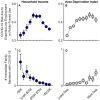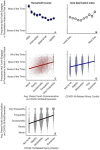This is a preprint.
Resilience to COVID-19: Socioeconomic Disadvantage Associated With Higher Positive Parent-youth Communication and Youth Disease-prevention Behavior
- PMID: 34013256
- PMCID: PMC8132250
- DOI: 10.21203/rs.3.rs-444161/v1
Resilience to COVID-19: Socioeconomic Disadvantage Associated With Higher Positive Parent-youth Communication and Youth Disease-prevention Behavior
Update in
-
Resilience to COVID-19: Socioeconomic Disadvantage Associated With Positive Caregiver-Youth Communication and Youth Preventative Actions.Front Public Health. 2022 Feb 9;10:734308. doi: 10.3389/fpubh.2022.734308. eCollection 2022. Front Public Health. 2022. PMID: 35223717 Free PMC article.
Abstract
Socioeconomic disadvantage is associated with larger COVID-19 disease burdens and pandemic-related economic impacts. We utilized the longitudinal Adolescent Brain Cognitive Development Study to understand how family- and neighborhood-level socioeconomic disadvantage relate to disease burden, family communication, and preventative responses to the pandemic in over 6,000 youth-parent/caregiver dyads. Data were collected at three timepoints (May to August 2020). Here, we show that both family- and neighborhood-level disadvantage were associated with parents’ reports of greater family COVID-19 exposure risk and diagnoses, less perceived exposure risk, more frequent parent-youth conversations about COVID-19 risk/prevention and reassurance, and greater youth preventative behaviors. More disadvantaged families may be adaptively incorporating more protective strategies to reduce emotional distress and likelihood of COVID-19 infection. The results highlight the importance of parent-youth communication and disease-preventative practices for buffering the economic and disease burdens of COVID-19, along with policies and programs that reduce these burdens for families with socioeconomic disadvantage.
Figures






References
Publication types
Grants and funding
- U24 DA041147/DA/NIDA NIH HHS/United States
- U01 DA051039/DA/NIDA NIH HHS/United States
- U01 DA041120/DA/NIDA NIH HHS/United States
- U01 DA051018/DA/NIDA NIH HHS/United States
- U01 DA041093/DA/NIDA NIH HHS/United States
- U24 DA041123/DA/NIDA NIH HHS/United States
- U01 DA051038/DA/NIDA NIH HHS/United States
- U01 DA051037/DA/NIDA NIH HHS/United States
- U01 DA051016/DA/NIDA NIH HHS/United States
- U01 DA041106/DA/NIDA NIH HHS/United States
- U01 DA041117/DA/NIDA NIH HHS/United States
- U01 DA041148/DA/NIDA NIH HHS/United States
- U01 DA041174/DA/NIDA NIH HHS/United States
- U01 DA041134/DA/NIDA NIH HHS/United States
- U01 DA041022/DA/NIDA NIH HHS/United States
- U01 DA041156/DA/NIDA NIH HHS/United States
- U01 DA050987/DA/NIDA NIH HHS/United States
- U01 DA041025/DA/NIDA NIH HHS/United States
- U01 DA050989/DA/NIDA NIH HHS/United States
- U01 DA041089/DA/NIDA NIH HHS/United States
- U01 DA050988/DA/NIDA NIH HHS/United States
- U01 DA041028/DA/NIDA NIH HHS/United States
- U01 DA041048/DA/NIDA NIH HHS/United States
LinkOut - more resources
Full Text Sources

